Did someone scribble on the VMS?
On Folio 66v, in the herbal section of the Voynich Manuscript, there’s a plant with scalloped leaves and some banana-like dark red roots. Researchers have expended enormous effort trying to identify the plants, with mixed results, but sometimes the Voynich serves up other puzzles in the margins or under the paint that beg to be solved.
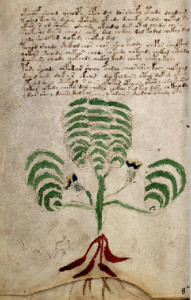 If you look to the left of the roots, there’s a messy blob of irregular lines that resemble marks that occur if you cut something on top of something else and the blade goes slightly through the upper layer—not enough to damage the lower layer, but enough to leave a mark. A piece of dyed fabric or paper would have a similar effect, of leaving a dark “pressure mark” on the lower layer. Before the 13th century, pinholes and pressure lines were used to rule parchment and vellum before adding the ink, but the VMS appears to be free of ruled lines. The text was added freeform.
If you look to the left of the roots, there’s a messy blob of irregular lines that resemble marks that occur if you cut something on top of something else and the blade goes slightly through the upper layer—not enough to damage the lower layer, but enough to leave a mark. A piece of dyed fabric or paper would have a similar effect, of leaving a dark “pressure mark” on the lower layer. Before the 13th century, pinholes and pressure lines were used to rule parchment and vellum before adding the ink, but the VMS appears to be free of ruled lines. The text was added freeform.
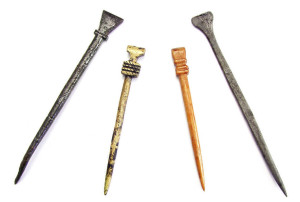 A stylus was a common tool for ruling an unobtrusive mark to help organize the text in lines and columns and was made from a variety of materials such as bone, wood, or brass. A stylus was also useful for composing text on wax tablets before committing them to parchment. But a stylus doesn’t leave dark marks (unless it were dipped in something). Its function is to create a slight dent without leaving an obvious line and the VMS scribble appears to have a small amount of pigment in the crevices.
A stylus was a common tool for ruling an unobtrusive mark to help organize the text in lines and columns and was made from a variety of materials such as bone, wood, or brass. A stylus was also useful for composing text on wax tablets before committing them to parchment. But a stylus doesn’t leave dark marks (unless it were dipped in something). Its function is to create a slight dent without leaving an obvious line and the VMS scribble appears to have a small amount of pigment in the crevices.
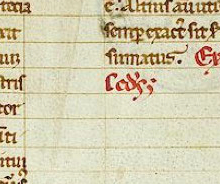
Guidelines were typically drawn to define columns and help align the flow of text, as in this 12th century manuscript.
The marks could result from use of a plummet—a leadpoint drawing instrument that evolved into our familiar graphite pencils. The scribble has that grayish color that is characteristic of lead-based impressions. Plummets were used to rule pages from about the early 13th century onwards but plummet marks are typically darker than the VMS scribble.
The VMS doesn’t have pinmarks at the ends of pages or pressure marks or lines like those that contain the flow of text, so it seems unlikely that a plummet was used for a marginal scribble when it isn’t evident in other parts of the VMS unless the scribbles were added in a different time period.
The VMS marks do have a certain kinship with silverpoint lines. Silverpoint is a pressure instrument that looks like an awl with a short point. The tip sheds just enough material to make a delicate line similar to a very light impression by what is called a “hard” pencil. Like the plummet, silverpoint was used to rule manuscripts in the middle ages and sometimes for drawing.
The fabulous image on the right is an example of silverpoint art. It was drawn by the young Leonardo da Vinci when he was an aspiring student.
So silverpoint might be one possibility, but the scribble looks a little too blunt in places to be silverpoint. Are there other possibilities?
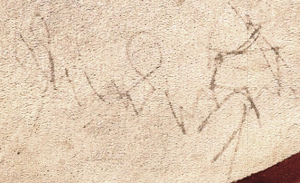 I wracked my brain trying to think of what other media might leave this kind of mark on parchment and it occurred to me that a basically empty quill pen might leave a barely legible impression if there were not enough ink for writing, but enough to make a light “tattoo” in the page.
I wracked my brain trying to think of what other media might leave this kind of mark on parchment and it occurred to me that a basically empty quill pen might leave a barely legible impression if there were not enough ink for writing, but enough to make a light “tattoo” in the page.
Well, maybe it’s not worth worrying about about what was used to make the mark, at least for now. What may be more interesting is dissecting the scribble to see if it yields any useful information about the manuscript.
A Hidden Message?
Is there a hidden message in the incisions? Or a painting instruction, as possibly evidenced in other parts of the VMS?
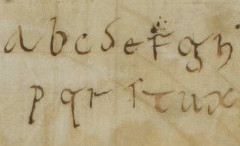 It didn’t feel that way to me. When I saw the marks, they reminded me of a child’s scribble. Scribbles and pen tests are not uncommon on old manuscripts. Youngsters learning to write sometimes practiced their alphabets on flyleaves or blank pages, or worked out artistic renditions of their names or initials. Drawings are sometimes included as well. The example on the right, from another manuscript, looks like it might have been done by a child around seven or eight years of age. We have to remember that medieval quill pens are harder to handle than ballpoint pens.
It didn’t feel that way to me. When I saw the marks, they reminded me of a child’s scribble. Scribbles and pen tests are not uncommon on old manuscripts. Youngsters learning to write sometimes practiced their alphabets on flyleaves or blank pages, or worked out artistic renditions of their names or initials. Drawings are sometimes included as well. The example on the right, from another manuscript, looks like it might have been done by a child around seven or eight years of age. We have to remember that medieval quill pens are harder to handle than ballpoint pens.
The VMS scribble is less sophisticated than the alphabet “pen test”, which could mean a difference in age, or a difference in ability and coordination skills. Sometimes it’s hard to tell.
Are there other scribbles in the Voynich Manuscript? Yes, there are. Under the main text of Folio 86v3, is a scribble in the middle of the page that looks even more like writing than the example posted above and of interest is the lightly incised blank TO-Map that looks like it may cross over the lines of the scribble, suggesting that the scribble may be as old as the manuscript or older. I’ve increased the contrast so the scribbles are easier to see:
Were the scribbles on the parchment before the Voynich text and images were added? Was the TO-map added by the VMS author or by someone else? Or were the map and the scribbles added during the process of creating the manuscript which may have taken many months or years?
Interpreting the Scribble on F66v
If you will indulge me for a moment, since I’m not suggesting I can interpret such a rough and barely visible scribble, but here’s what it looked to me the first time I saw it. I’ve upped the contrast so it’s easier to see.
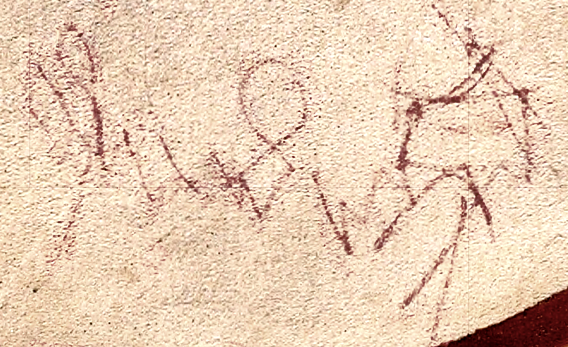 Is that a name on the left, something like “John” or “Justin” or a word like “Juden” or “Yuden” and a human stick figure with a pointed hat on the right? It’s not very common for children to draw square heads but it does look like it might have eyes, two arms and two legs. The letter “J” was not part of the regular alphabet in some languages, but it was sometimes written as a capital “I” with a partial descender (as in “Iulian” or “Iuden” or “Iesus”) even in languages where “J” was not commonly used.
Is that a name on the left, something like “John” or “Justin” or a word like “Juden” or “Yuden” and a human stick figure with a pointed hat on the right? It’s not very common for children to draw square heads but it does look like it might have eyes, two arms and two legs. The letter “J” was not part of the regular alphabet in some languages, but it was sometimes written as a capital “I” with a partial descender (as in “Iulian” or “Iuden” or “Iesus”) even in languages where “J” was not commonly used.
Here’s another version in which I’ve used two different colors to separate the part that looks like writing and the part that looks like a stick figure:
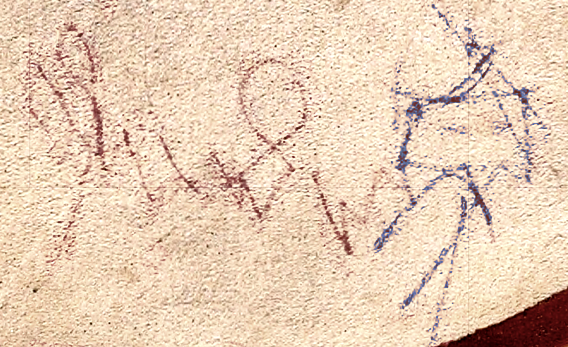 Or is it a coincidence that it almost looks like text and almost looks like a drawing? Was it added at the time the VMS was created? Was there a child in the room with the manuscript? Or could it have been added a century or two later?
Or is it a coincidence that it almost looks like text and almost looks like a drawing? Was it added at the time the VMS was created? Was there a child in the room with the manuscript? Or could it have been added a century or two later?
Summary
Unfortunately, scribbles are like clouds—they can resemble things we recognize completely by coincidence or by our brain’s tendency to pay attention to shapes that are familiar. The 86v scribbles do look like text, but they doesn’t appear to spell anything. The 66v scribbles are more enigmatic.
I would love to discover something in the manuscript that could help us understand it better, but we may never know whether this scribble is meaningful or whether it’s just random lines or a child’s attempt to create something that looks like real writing.
J.K. Petersen
© Copyright 2016 J.K. Petersen, All Rights Reserved

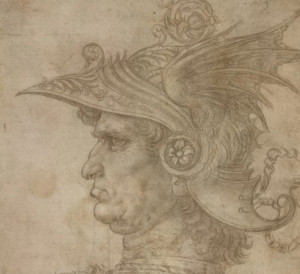
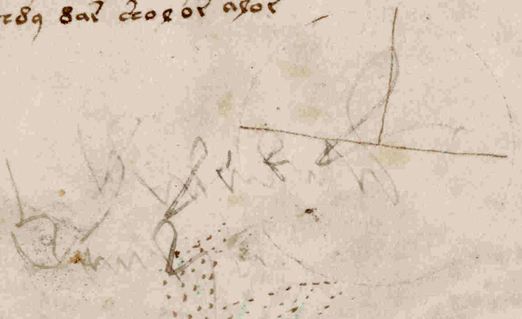
86v3 folio –
Michael Voynich decipher the scrawl. It’s a name. ( scrawl = name).
Do you know which letter to Yale ?
The letter is written instruction to decrypt manuscript.
Complete instuctions for translation.
I’ve written about the “chicken scratches” a fair few times, which you may well not have seen:
http://ciphermysteries.com/2010/07/20/voynich-chicken-scratches
http://ciphermysteries.com/2010/08/18/the-secret-history-of-voynich-chicken-scratches
http://ciphermysteries.com/2012/04/22/voynich-centenary-nicks-quire-number-presentation-preliminary
You’re right, Nick, I haven’t seen them, but I’m happy to post the links for people who are interested and will add them to my “things to read” list for when I have time.